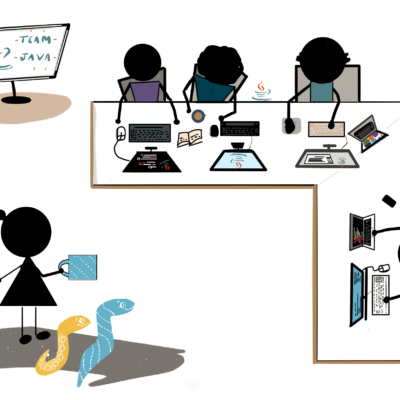Since AI is advancing faster than regulation and innovation is outpacing understanding, two principles must rise above the noise: trust and responsible innovation.
That was the central message for industry leaders during another day of SAS Innovate 2025. Show host and recently named Chief Operating Officer Gavin Day said this core tenet begins before the first line of code is written.
“These are really volatile and uncertain times, perhaps the most volatile we’ve faced in our careers,” he said. But it’s not new territory for SAS, which is on the brink of 50 years in business. “We’ve seen everything, so we’re here to help you through anything, especially when we know market forces are working for and against you.”

Goodnight and Nadella on the big picture
But even with a partner like SAS, he believes organizational success and the ability to forge through challenging times begin at the top. Day said there are no better examples – “titans,” he called them – than SAS CEO Jim Goodnight and Microsoft Chairman and CEO Satya Nadella.
The two engaged in a recorded video discussion that helped set the tone for the event, discussing topics that included co-innovation efforts, AI and quantum computing.
“Moore’s Law is essentially on hyperdrive with these models and models’ capabilities,” Nadella said, referencing the idea that the speed and capability of computers can be expected to double every two years. “The real trick is to be able to parlay that advancement in model capability into actual, useful products.”
Goodnight talked about how the scale of data has also evolved at an increasing speed, but noted that neither of their organizations feels generative AI is the answer to everything. “We know that many of our customers have complex workflows that require a full spectrum of AI capabilities beyond generative AI,” he said. “I’m excited about our co-innovation with Microsoft, like SAS® Decision Builder on Microsoft Fabric, which is now in public preview, and SAS® Viya® Workbench on Azure Marketplace.” He said SAS is also getting positive customer feedback about SAS Viya Copilot. “We appreciate all that your Microsoft teams have put into making these innovations successful.”
“There’s power, there’s the ever-increasing capability and the reduction in prices,” said Nadella. “But the more interesting thing is the product building around it.”
‘Responsible innovation begins with responsible innovators’
Regardless of industry and overwhelming amounts of data, “it’s the decisions that drive your organizations, not your data,” Day said. “That’s why we obsess over providing you with knowledge … so you can make the right decisions for your organization at the right time.” At the center of those decisions: trust. “You can’t afford to get it wrong. That means we can’t either. … Without trust, decisioning is compromised.”
Trust is practically Reggie Townsend’s middle name as SAS’ Data Ethics Practice VP, so it was no surprise to hear him discuss it during the session.
“We’re on the precipice of some real humankind-changing stuff,” he said. Townsend believes it’s kind of like that revolutionary time when the earliest mirrors – often pools of water seen in nature – began to change how humans saw themselves for the first time.
We’re peering into a different kind of mirror today: AI. “Like those first reflecting surfaces, AI is changing how we see ourselves and envision our future,” he said. It’s a reflection that sometimes offers a clear vision of who we are, and sometimes it’s a distortion. AI magnifies our wisdom, shortsightedness, brilliance and biases.”
Townsend believes responsible innovation begins with responsible innovators: you and me. And the responsibility extends well beyond governments and regulations. We all have choices to make.
“If we truly believe that we’re at the crossroads of a technology reshaping society, then right now is an all-in moment.” That moment calls for new methods, like SAS’ new AI Governance Map and interactive assessment tool, particularly as we move decision-making to artificial intelligence.
Townsend welcomed Her Excellency Mubaraka Ibrahim, Chief Artificial Intelligence Officer and CIO, Emirates Health Services, UAE, to the stage to discuss how solid governance approaches can work to guide technological advancement for greater success. She shared details about her agency’s efforts to elevate health care, build trust with providers and patients, and close the equity gap to ensure everyone can access the best possible experience.

With visionary leadership and a partnership with SAS, Ibrahim says they have enhanced clinical outcomes, reduced provider burnout, increased financial efficiencies and enhanced patient engagement and patient outcomes. “It’s concentrated on the patient – on the heart – of any innovation we do,” she said.
AI in clinical decision-making
Alyssa Farrell, Director of Global Industry Strategy, Health & Life Sciences, took the stage to discuss the heightened levels of sensitivity, privacy and governance required of AI and technology in her industry focus, where decisions and outcomes are highly regulated and life-changing. “In an AI world, trust is the currency we trade in when implementing these technologies,” she said.
Farrell welcomed Dr. Michel van Genderen, Internist-Intensivist, who represented Erasmus MC and TUDelft and their collaborative effort called REAIHL (Responsible and Ethical AI Healthcare Lab). He began by discussing one of the industry’s most foundational challenges today: a shortage of health care professionals combined with a growing demand for services.
Van Genderen believes AI can help address that dilemma, but within parameters. “I will only use AI when I’m confident it is safe, explainable and trustworthy,” he said. “Because in my line of work, decisions can be the difference between life and death. … Together with the WHO (World Health Organization), leading European hospitals, the TUDelft and SAS, we are working toward redesigning how we work.”

He discussed an effort with leading US and European AI-driven hospitals focused on key global considerations, such as AI model inventory and bias assessment, to determine their maturity level around trust and accountability.
“Without trust and understanding, clinicians will never use it at the bedside when making clinical decisions,” said van Genderen. As a physician, he wants to know if a model works for a particular patient, in a particular situation or moment. That requires understanding what clinicians need and how AI tools will be used. “We are not only building it for them … we are building it with them,” he said.

Erasmus built and implemented a real-time, mechanical ventilation performance dashboard that offered continuous insights. Through this dashboard, the number of patients who received optimal mechanical ventilation settings doubled when nurses and doctors determined their efforts based on this data, on evening, weekend, and day shifts.
“Relatively simple AI solutions can already improve the quality of health care,” van Genderen said. “It’s not just about developing very complex and difficult models. It’s about understanding each other’s language. It’s about clinical and technological innovation in partnership.”
Using AI to stay relevant
While decision-making in retail may not be life or death, it can totally affect a brand’s customer experience and lasting reputation. Kate Parker, Sr Director of the Customer Intelligence Practice, and her on-stage guest, Bennett Fox-Glassman, Senior Vice President of Customer Journey at Macy’s, understand that pressure firsthand.
“Data is the foundation for decisions to positively impact the customer experience,” said Parker. “Bad data can lead to bad AI, and bad AI can lead to poor decisions. And no one has time for poor decisions.”
Fox-Glassman said Macy’s is working to rewire how they think and work across the organization so everything is focused on improving customer experience. “Ultimately, that’s what leads to more profitable, sustainable growth … but it’s through the lens of the customer.” Their loyalty program and personalization are just a couple of ways they’re leaning in, although Fox-Glassman said no one ever comes into a store and asks for more personalization.

But, they expect context and relevance, so Macy’s is striving to create more “triggered” or “contextually relevant” communications with the help of SAS® Customer Intelligence 360. “As we do more of that, the level of decisioning and arbitration – what should I send you and when to really get that message right – becomes more and more complex,” he said. They’re looking for long-term outcomes that strengthen customer loyalty and retention.

Fox-Glassman advised audience members to be “extremely use case driven” when seeking the technology investments to help build that AI foundation. For Macy’s, that means focusing priorities and investment around the customer experience and brand trust, which he believes is built daily and with every interaction.
“We, like many, are experimenting. We’ve been using AI for many years in areas like pricing and supply chain, but the evolution of these new technologies… we’re learning our way through it.” He said they’re using these new technologies more internally at this point.
Parker closed the segment by sharing details of new technology enhancements for marketers and the AI teams that support them.
AI agents boost decision confidence, productivity
“Agentic AI is the next frontier,” Day said. “You need agents that can make smart, explainable, trusted decisions, whether working independently or with your team. That’s exactly what SAS brings.”
To explain how, he introduced Diana Maris, Product Manager, SAS Intelligent Decisioning.

Maris described SAS’ approach through a customer scenario use case that demonstrated how SAS combines generative and deterministic methods layered with data governance, guardrails and business rules to mitigate risk. “Some agents act autonomously, like the one that retrieves, summarizes and escalates complaints, while others advise the human on how to make the decision,” Maris said.

She then showed on screen and in real time how the customer support person would interact – using natural language – with the AI agent, which is much more than a chatbot and has a full view of the customer in question.
She demonstrated how the AI agent gathers and summarizes the complaint, scores churn risk, and creates recommendations and customized offers for the employee, all within guidelines and regulations and in mere seconds. “At SAS, trust is not just a buzzword. Every decision is logged, auditable and available for tracking. … We give you the tools to confidently build, govern and validate AI-driven decisions.”
Day returned to the stage to close out the remarkable and mind-blowing session with one final message about responsible innovation.
“We don’t have to sacrifice trustworthiness to take advantage of innovation,” he said. “We’re here to guide you into the AI future.”





